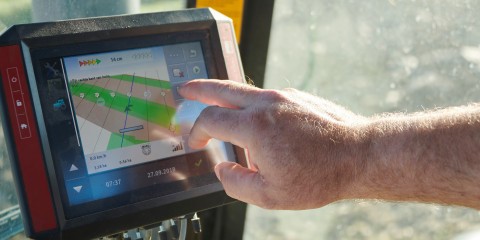On farm experimentation with innovative smart farming techniques in irrigation, weed and disease detection and fertilization
29 April 2022 by Admin

On farm experimentation (OFE) was an unfamiliar term to the public but is certainly not a new concept. On farm experimentation is when the trials are carried out on a commercial farm and the grower has a say in the trial design. In this way we immediately know that the subject is highly relevant to the sector. Thanks to this collaboration, there is also an exchange of knowledge and all parties involved can learn from each other. On farm experimentation can accelerate innovation by familiarising growers with new techniques under the guidance of experts.
"It is necessary to put the farmer's challenge at the centre and show the possibilities of smartfarming, even at a beginner's level." – Participant at the smartfarming info event
What does on farm experimentation look like?
The four on farm experimentation examples featured during the event each got to work with growers, yet the trial looked completely different each time. In this way we showed that on farm experimentation can take many forms. The approach 'accelerate innovation' is the common thread in each case.
Irrigation advice for leek cultivation
Anne Waverijn of PCG talked about irrigation advice in leek cultivation, whereby the soil moisture content was monitored using sensors. With the data from these sensors and other small amounts of data about the crop and the plot, they want to make irrigation recommendations in the future based on a soil water balance model. PCG investigated the effects of drip irrigation on leeks. In 2020, positive results were obtained with drip irrigation. In 2021, due to wet weather conditions, the effects of drip irrigation were less.
You can use this handy tool to calculate the cost of irrigation for your plots:
https://beregeningstool.pcgroenteteelt.be/
Alternaria detection in potatoes and weed detection in corn
Jonathan Van Beek of ILVO showed us how potato plants with Alternaria infection are easier to recognize if we use sensors with near-infrared light. You can attach these sensors to moving vehicles, such as a tractor or drone. Using artificial intelligence, Altenaria can be detected on new images after training a model. This allows you to create a map with site-specific treatments where needed. Jonathan also showed a second example of artificial intelligence in agriculture, where weeds were detected via drones. For this, a model was again trained to recognize the weeds with artificial intelligence to create an application map for control. The model was trained by choosing among photos each time the one with the most weeds. This example used 5G to transmit the images in real-time from the drone to the sprayer.
"Precision agriculture is no longer science fiction. It does need to be refined, especially in vegetable farming where fields are smaller and crops are more intensive." - Participant at the smartfarming info event
Using crop sensors in peas and onions
Susie Roques from ADAS from the UK gave us some tips on how to create and statistically process an on farm trial. ADAS has developed a special statistical method for the statistical processing of trials laid out in wide strips: the "Agronomics" analysis. With this method, you can quickly find out if a new method is better than the standard method the grower normally uses. Susie showed an example of how to use drone imagery to create a predictive yield map. This year the INNO-VEG project will publish another manual of how to set up your own on farm experiments.
Join the INNO-VEG network and stay up to date with new publications
https://www.inno-veg.org/nl/Account/Register
Site-specific fertilization in leeks
Tim Decuypere from Inagro explained how we applied site-specific fertilization in leeks together with ten growers. The aim was to fertilize leeks at the right time with a dose that takes into account the variation within the field. Management zones were defined using soil samples, a soil scan and the Ecofert crop growth model. Drone imagery and harvest determinations were used to evaluate site-specific fertilization rates. By optimizing fertilization, we can maximize yield and reduce the risk of exceeding nitrogen standards.
Demonstration AgroIntelli Robotti
We ended the day with a first demonstration of the AgroIntelli Robotti that we are testing at Inagro. This robot can carry standard implements thanks to its three-point suspension and performs its tasks autonomously with RTK-GPS. Despite dust clouds near the robot bringing it to a standstill (due to the safety sensors), the robot was able to successfully sow maize on our test plot.



